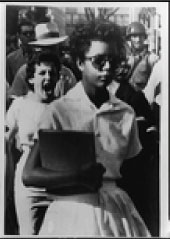School Desegregation In Elementary and Secondary Education
For more than a century, African Americans fought for equal educational opportunity. The history of this struggle is best summarized through a review of legal challenges. The earliest reported case was in 1849, Roberts v. the City of Boston. Parents petitioned that their children should be allowed to attend schools in Boston other than the segregated Smith School. However, the court ruled that it was sufficient that provisions had been made for the “colored students” to have a school
The next major ruling came in 1896, in the Supreme Court case Plessy v. Ferguson, which supported “separate but equal” segregation of
 |
|
|
Elizabeth Eckford is yelled at and blocked from entering Central High, 1957 |
the races. This decision was finally overturned in Brown v. Board of Education of Topeka, Kansas in 1954, when the Supreme Court unanimously ruled that segregation in public schools was unconstitutional, and that separate educational facilities are inherently unequal. However, desegregation was met with much resistance, particularly in the southern states.
Virginia legislators passed a resolution in 1956 that the Supreme Court’s decision to integrate schools was incompatible with the state
constitution, and gave the governor power to close down any school system that attempted to desegregate.
In Little Rock, Arkansas in September of 1957, Governor Orval Faubus used the National Guard to block nine Black students from entering the all-White Little Rock Central High School. Although President Eisenhower sent federal troops to intervene on behalf of the students, who become known as the “Little Rock Nine,” the threats and intimidation continued.
When the Civil Rights Act of 1964 was signed, it provided the federal government with the powers to enforce desegregation by denying federal funds to any program which discriminated on the basis of race, color, religion or national origin.
In 1968, in Green v. County School Board of New Kent County, Virginia, the Supreme Court ruled that it was unconstitutional that the
 |
|
|
School segregation protest |
county was operating a dual system of schools, and that is must convert to one system. It stipulated that school boards have a duty to eliminate imposed segregation, and to integrate schools.
In 1971, the Supreme Court, in Swann v. Charlotte-Mecklenburg Board of Education, upheld busing as a tool for integrating public schools and correcting racial imbalances. Court-ordered busing plans continued in some cities until the late 1990s.
Arguments in support of achieving diversity in public elementary and secondary education say that it is a critical period for transmitting societal values, promoting discussion between the races and fostering cultural understanding. However, in 2006, the Supreme Court agreed to hear two major cases regarding practices used to maintain diverse learning environments in public schools, even though the lower courts had upheld the school districts’ practices. In both cases, one in Seattle and the other in Louisville, parents of White students sued the school districts when their children were refused admission into popular area schools, claiming that using race in student assignments denied their rights. In November of 2006, Michigan passed Proposal 2, which banned preferential treatment, claiming that affirmative action programs deny qualified applicants. As of December 2006, four states have banned affirmative action policies: Michigan, California, Texas, and Washington.
|
Desegregation |







